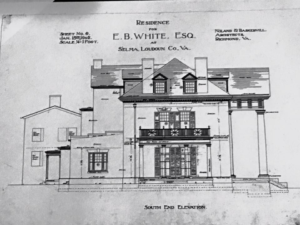

Before they were what they are today, the lands of Selma were a part of the Northern Neck Proprietary owned by Lord Fairfax. In 1741, they were purchased by Ann Stevens Thomson Mason, the widow of George Mason III, who bought 10,000-acres and held onto the land as an inheritance for her children, George Mason IV, Thomson Mason, and Ann Eilbeck Mason.
The southern portion of the property was bequeathed to the elder son, George Mason IV (Father of the Bill of Rights) and became Gunston Hall. The northern part of the property, which includes part of the present-day Selma lands, was inherited by the younger son, Thomson Mason. In 1760, and in addition to his inheritance, Thomson Mason purchased the neighboring 322-acre Raspberry Plain farm that included a smaller mansion and jailhouse from Aeneas Campbell, Loudoun County’s first sheriff. Thomson Mason resided in the Campbell house until completion of the new Raspberry Plain mansion in 1771 at which time the Campbell parcel was renamed Strawberry Plain.
In 1808, Stevens Mason’s second eldest son, Armistead Thomson Mason, inherited approximately 1,000 acres that included a portion of the original Mason Tract and the Aeneas Campbell Tract. In 1810, he built an exquisite mansion at the base of Catoctin Mountain overlooking a sweeping vista of lawn and pastural farmland. The mansion and plantation were named Selma, inspired by the translation of a Gaelic poem by Sir John McPherson with “Selma” meaning “Beautiful Castle” or “Highest Place”.
Over the years the property has been passed down from the Mason family to the Beverleys, Swans, Whites, Eppersons and one ter Maaten, enduring a Civil War raid in the 1860s, a destructive fire in the 1890s, and a top to bottom reconstruction undertaken by Sharon and Scott in 2016 after years of neglect and vandalism.
Selma Mansion is located in Loudoun County Virginia in the town of Leesburg – a town and district of great historical value within the context of American independence and establishment. With its location so near to the East Coast and to the nation’s capital, Loudoun County has housed many political and historical figures and seen plenty of noteworthy events throughout American history.
Colonial settlers arrived in the Loudoun County area as far back as the early 1700s, many of them Quakers from various towns along the East Coast. They settled on the land granted to Lord Fairfax by King Charles II.
As the country drew nearer to the Revolutionary War, Loudoun County citizens gathered in courthouses to protest laws and taxes imposed on the American citizens by the British Monarchy. Many men from Loudoun County went on to fight in the Revolutionary War, and the Declaration of Independence was read in Loudoun County in 1776. Francis Lightfoot Lee, the son of the eponymous Thomas Lee of Leesburg, was a signer.
During the war of 1812, Loudoun County temporarily served as a refuge for President James Madison when the British burned Washington. Along with the president, Loudoun County protected the constitution, and some other important state documents during this time.
Additionally, one of the first battles of the Civil War, The Battle of Ball’s Bluff, was also fought in Loudoun County. Colonel John Mosby, a well-known Confederate battalion commander, led raids in the area, and Loudoun County also served as a home to the Laurel Brigade, a well-known Confederate cavalry unit commanded by Elijah V. White. Names such as President James Monroe and Marquis de la Fayette were in and out of Loudoun County – Monroe as a resident and Lafayette as a temporary visitor.
Due to the rich activity in the area, the Mason family of Selma was inevitably linked to high profile figures in U.S history. Stevens Mason served as an aide to George Washington at the Battle of Yorktown and was a close personal friend of Thomas Jefferson, the eventual third President of the United States.
Please visit the links below for additional information on Loudoun County History:
With Leesburg in Their Sights, Union Troops Caught by Surprise at Ball’s Bluff
